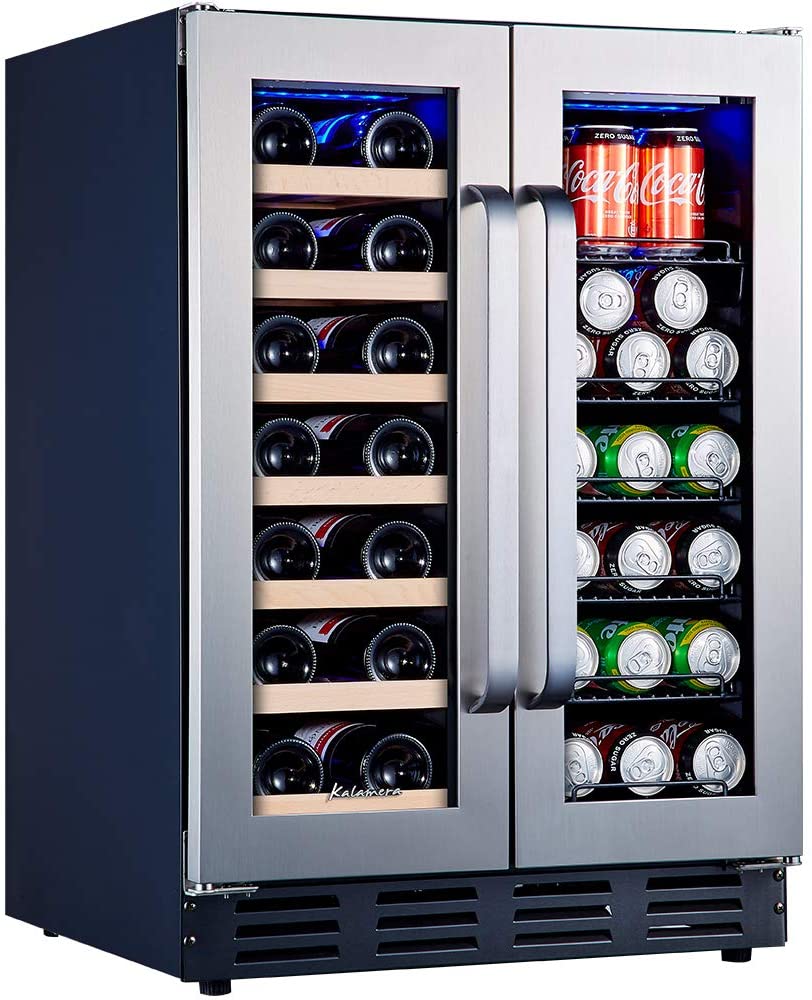While ageing generally benefits wines, this only works if your bottles are stored correctly. Wine fridges are designed for the long-term storage of wines in optimal conditions.
Getting the Right Temperature
Red and white wine have the same ideal storage temperature of 12°C to 18°C. Maintaining a constant temperature for a long time is difficult without some kind of refrigerator. However, standard refrigerators operate from 1.7°C to 3.3°C.
There is a difference between ideal storage and serving temperatures. Temperature affects flavour and you need to let your reds warm up, and your whites chill before pouring.
Is a Bar Fridge Good Enough
Wine fridges are different from other fridges in many ways. Firstly, they are designed to maintain a much warmer temperature. Secondly, wine fridges are much better at maintaining humidity levels which other fridges cannot. Finally, wine fridges have special shelves that reduce vibrations to better store wine.
Cellaring vs Serving
Your wine fridge can be used for either cellaring or serving, and most people use theirs for the former. However, some wine fridges have different temperature zones allowing them to fulfil both roles.
How Big does it need to be?
Different wine fridges have a capacity ranging from a few bottles to several cases. When choosing your wine fridge, start with your collection and figure out how much space you need. Then, always go a little bit bigger if you can afford it to allow for some flexibility. Do not forget your new fridge needs to fit in your home somewhere too.
Aspects of a Wine Fridge
Location
Think about where in your home your wine fridge will go. If it is somewhere often used by people then it needs to be quiet. If you want it in your kitchen it needs to stay away from the oven. Garages and attics are not great spaces due to the constant changes in temperature and humidity. Also, leave plenty of space around the sides while avoiding direct sunlight.
Doors
Glass doors are great for finding what you want without opening the door and letting the temperature change. If you opt for glass, make sure it comes with a UV protective coating. Solid doors have better innate UV protection and insulation but make it harder to find what you want, especially in the bigger models.
Capacity
How many bottles do you store? If the answer is a lot but you do not have a large space for a new fridge, then you may need two smaller models. People who buy single bottles at a time can get away with smaller fridges which are far less imposing.
Sparkling Wine Storage
Bottles containing sparkling wine are typically wider than their counterparts. If you want to store a lot of these bottles, you need to remember that a bigger wine fridge may be required.
Shelving
Metal shelves are better at carrying vibrations and can scratch your bottles’ labels. Quality wine fridges come with wooden shelving and are fitted with sliding mechanisms for ease of access. However, metal shelves are thinner allowing for increased storage capacity.
Bulk Storage Options
In some wine fridges, you can stack your bottles directly on top of one another. This lets you fit more bottles inside it but makes the bottom ones harder to access. Bottles stored this way are also more prone to scratches and breaking. Individual bottle storage gives you a lower capacity but keeps your wine safer.
Lights
Bigger fridges can utilise LES lights so you can easily see further back into the fridge when looking for the right bottle.
Humidity Controls
Cork-sealed wines require about 70% humidity to maintain a good seal. To facilitate this, some wine fridges come with dedicated control systems in the form of a water reservoir that must be topped up from time to time. However, if you mostly drink wine with screw-caps, this is not an essential feature.
Multiple Temperature Zones
If you want to store both red and white wine at both cellar and serving temperatures, you need a multi-zone wine fridge. These usually have a warmer section at the top and a colder section lower down allowing you to move your wine into an appropriate spot when transitioning it from storage to serving.
Low Vibration
Any compressor-type wine fridge will vibrate. Whether or not this has a negative impact on your wine is up for debate. There have been studies along with anecdotal evidence that suggests stronger vibrations leads to worse wine. If you want to be sure, opt for a wine fridge that vibrates as little as possible.
Tips for Storing your Wine
- Your storage temperate should never be too hot or your wine will spoil. Try and maintain your wine storage between 12°C and 18°C. If you do not yet have a wine fridge which is capable of performing this task, always opt for colder rather than hotter.
- Store your wine collection in a dark space. At a minimum, you must keep it out of direct sunlight and away from external sources of heat or cold.
- Do not store your wine in a garage. Both the temperature and humidity will fluctuate which will degrade your wines’ quality.
- Do not store your wine in a draughty environment. This leads to the same issues as storing it in a garage.
- When you do not have a wine fridge, store your wine in a foam box or other insulating material. Then, place a thermometer in the storage container so you can check that temperature is maintaining a consistent level.
- Do not store your wine for too long. Wine has a shelf life and getting the best out of it means eventually drinking it. The best storage conditions can mitigate a lot of the issues that cause degradation but they cannot prevent it forever. So, if you have a nice bottle stored away for a special event, make sure you remember to actually use it to celebrate something.


